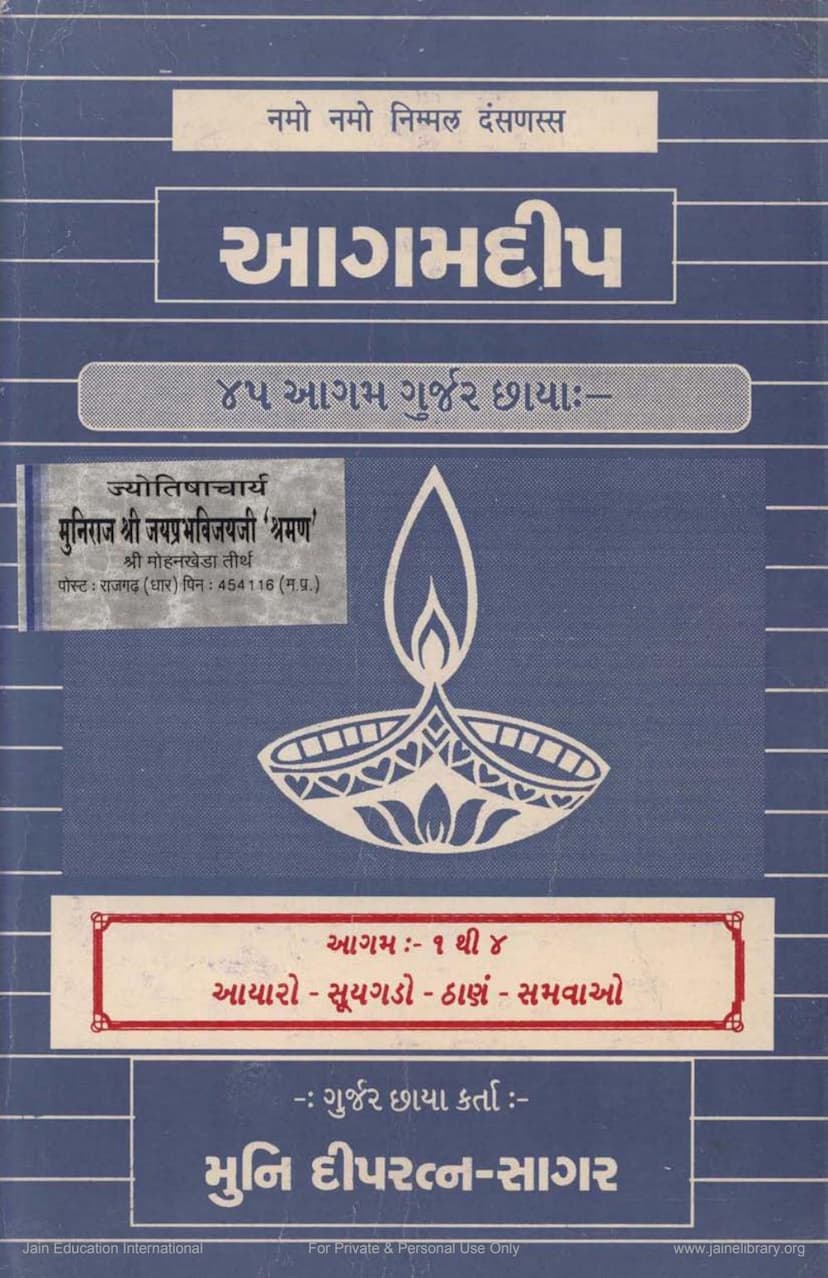Agam Deep 26 MahaPacchakhanam Gujarati Anuvaad
Added to library: September 1, 2025

Summary
This document is a Gujarati translation (Anuvaad) of the Jain text "Maha Pacchakhanam", which is part of the "Agam Deep" series, specifically volume 26. The book is authored by Muni Dipratnasagar and published by Agam Shrut Prakashan. The catalog link provided is for the Jainqq.org website.
Here's a comprehensive summary of the content based on the provided pages:
Overall Purpose and Context:
- The document is a Gujarati commentary or "Chhaya" (shadow/explanation) of the Jain text "Maha Pacchakhanam," which focuses on Great Vows or Renunciations.
- It is part of a larger project, "Agam Deep," which aims to provide Gujarati explanations of various Jain Agamas (scriptures). This particular volume, Agam Deep 26, covers the third "Payanna" (Prakirna), which is the "Maha Pacchakhanam."
- The publication is dedicated to promoting Jain knowledge and is supported by various individuals and organizations, as indicated by the list of "Mukhya Dravya Sahayak" (main financial supporters) on pages 3 and 5.
Key Content and Themes:
The "Maha Pacchakhanam" itself appears to be a detailed exposition of spiritual practices, vows, and renouncements within Jainism. The Gujarati translation and commentary cover a wide range of topics related to the path to liberation (moksha):
- Invocation and Salutations: The text begins with invocations to Tirthankaras, Jinas, Siddhas, and saints, and expresses respect for the pure teachings (Nirmal Deshan) and the Pancha Paramagames (Arhants, Siddhas, Acharyas, Upadhyayas, Sadhu). (Page 1, 2, 11, 15, 17)
- The Act of Renunciation (Pacchakhanam/Pacchakhan): A significant portion of the text details the process and philosophy of renouncing various actions, desires, attachments, and impurities. This includes:
- Vow-taking and Commitment: The text outlines the process of taking vows and making commitments. (Page 11)
- Renouncing Actions and Desires: This includes renouncing negative mental states (like anger, pride, delusion, greed), attachments to possessions, body, and even food. (Page 11, 12, 13, 14, 16, 17)
- Acknowledging and Repenting Past Actions: The text emphasizes the importance of recognizing, regretting, and confessing past wrongdoings ("Aalochana," "Ninda," "Gaha"). (Page 11, 12)
- Seeking Forgiveness: Expressing forgiveness to all beings and seeking forgiveness from them is a key theme. (Page 11)
- Mind, Speech, and Body Control: The emphasis on control through mana (mind), vachan (speech), and kaya (body) is recurrent. (Page 11, 12, 14, 15, 16)
- Renouncing Attachment (Mamta Tyag): The text speaks about renouncing attachment to one's self, knowledge, perception, conduct, and possessions, understanding their impermanent nature. (Page 11, 12)
- The Self as the True Support: The idea that the soul (Atma) is the true refuge and is intrinsically linked to knowledge, perception, and conduct is highlighted. (Page 11)
- The Nature of the Self and Samsara:
- Individuality of the Soul: The text repeatedly emphasizes that the soul is alone at birth, death, and in experiencing the fruits of its karma. (Page 11, 12, 13)
- The Cycle of Birth and Death (Samsara): The vastness of the cycle of rebirth, the immense suffering endured in various life forms, and the countless lives lived are described. (Page 13, 14)
- Desire and Dissatisfaction: The text points out that worldly pleasures, sensory experiences, and even divine enjoyments cannot satisfy the soul, leading to an unending cycle of desire. (Page 13, 14)
- The Path to Liberation:
- Patience and Endurance (Parishaha): The text stresses the importance of enduring hardships (Parishaha) with equanimity and determination. (Page 15, 16)
- Right Knowledge, Faith, and Conduct: The significance of right knowledge (Jnana), right faith (Darshan), and right conduct (Charitra) as the path to liberation is central. (Page 15, 17)
- Austerities and Penance (Tapa): The text mentions the role of austerities in burning away past karma. (Page 16)
- Meditative Practices (Dhyana) and Contemplation (Bhavana): These are presented as essential for spiritual progress. (Page 16)
- The Ideal Death (Pandit Maran): The concept of a "wise death" (Pandit Maran) – a death with complete awareness, equanimity, and without attachment – is highly praised as a means to break the cycle of rebirth. (Page 13, 14, 16)
- The Five Great Vows (Pancha Mahavrata): These vows are repeatedly mentioned as the foundation for spiritual practice. (Page 14, 15)
- Discipline and Restraint: The text emphasizes the importance of discipline in mind, speech, and body, along with the control of senses. (Page 14, 15, 16)
- The Role of the Guru: The guidance and teachings of the Guru are crucial for understanding and practicing the spiritual path. (Page 12, 15, 16)
- The Agam Series and Publishers:
- Pages 2, 3, and the later pages extensively list the "Agam Deep" series, detailing the various Agamas covered and their respective volume numbers within the series. This includes the Angas, Upangas, Prakirnas, Chedasutras, and Mulasutras of the Jain canon. (Page 8, 9, 10)
- The publisher, Agam Shrut Prakashan, and other associated publications are also mentioned. (Page 2, 7)
- The price of the "Agam Deep - Gurjar Chhaya" set is listed as Rs. 2000. (Page 3)
Structure and Presentation:
- The text is presented in Gujarati.
- It includes verse numbers (e.g., [1], [4-5], [9]) which likely correspond to specific verses or sections within the original "Maha Pacchakhanam."
- The commentary by Muni Dipratnasagar explains and elaborates on these verses.
- The pages are organized with clear headings and numbering.
In essence, "Agam Deep 26 Maha Pacchakhanam Gujarati Anuvaad" is a spiritual guide that delves into the profound Jain principles of renunciation, self-discipline, understanding the cycle of existence, and the ultimate path to liberation through the rigorous practice of vows and spiritual disciplines, all explained in the Gujarati language.